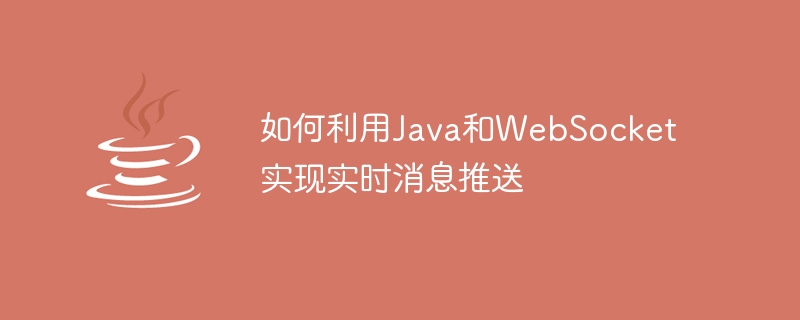Home >Java >javaTutorial >How to use Java and WebSocket to implement real-time message push
How to use Java and WebSocket to implement real-time message push
- WBOYWBOYWBOYWBOYWBOYWBOYWBOYWBOYWBOYWBOYWBOYWBOYWBOriginal
- 2023-12-17 10:53:351631browse

How to use Java and WebSocket to implement real-time message push
Introduction:
In today's Internet era, real-time message push has become one of the basic functions of many applications , such as chat applications, real-time data monitoring systems, etc. WebSocket, as a protocol that supports real-time two-way communication, has become one of the commonly used technologies for real-time message push. This article will introduce how to use Java and WebSocket to implement real-time message push and provide corresponding code examples.
1. Build the development environment
First, we need to prepare the Java development environment and WebSocket-related libraries. You can use a Java IDE such as Eclipse or IntelliJ as a development tool, and make sure the Java SDK is installed. In addition, we need to use the WebSocket related classes and methods provided in the Java API. You can introduce related libraries by adding the following dependencies in the pom.xml file:
<dependencies>
<dependency>
<groupId>javax.websocket</groupId>
<artifactId>javax.websocket-api</artifactId>
<version>1.1</version>
</dependency>
<dependency>
<groupId>javax.websocket</groupId>
<artifactId>javax.websocket-client-api</artifactId>
<version>1.1</version>
</dependency>
<dependency>
<groupId>org.glassfish.tyrus</groupId>
<artifactId>tyrus-client</artifactId>
<version>1.13</version>
</dependency>
</dependencies> 2. Create a WebSocket server
in Java , we can use the tyrus library to create a WebSocket server. First define a class to implement the Endpoint interface, and override onOpen, onClose, onError, onMessage and other methods to handle WebSocket connections, closures, errors and received messages.
import javax.websocket.CloseReason;
import javax.websocket.Endpoint;
import javax.websocket.EndpointConfig;
import javax.websocket.MessageHandler;
import javax.websocket.Session;
public class MyWebSocketServer extends Endpoint {
@Override
public void onOpen(Session session, EndpointConfig config) {
session.addMessageHandler(new MessageHandler.Whole<String>() {
@Override
public void onMessage(String message) {
// 处理接收到的消息
}
});
}
@Override
public void onClose(Session session, CloseReason closeReason) {
// 处理连接关闭事件
}
@Override
public void onError(Session session, Throwable thr) {
// 处理错误事件
}
}3. Create WebSocket client
In Java, we can use the tyrus library to create a WebSocket client. First create a class to implement the ClientEndpoint interface and override methods such as onOpen, onClose, onError and onMessage.
import javax.websocket.ClientEndpoint;
import javax.websocket.CloseReason;
import javax.websocket.EndpointConfig;
import javax.websocket.MessageHandler;
import javax.websocket.Session;
@ClientEndpoint
public class MyWebSocketClient {
private Session session;
@OnOpen
public void onOpen(Session session, EndpointConfig config) {
this.session = session;
session.addMessageHandler(new MessageHandler.Whole<String>() {
@Override
public void onMessage(String message) {
// 处理接收到的消息
}
});
}
@OnClose
public void onClose(Session session, CloseReason closeReason) {
// 处理连接关闭事件
}
@OnError
public void onError(Session session, Throwable thr) {
// 处理错误事件
}
public void sendMessage(String message) throws IOException {
session.getBasicRemote().sendText(message);
}
}4. Start the WebSocket server and client
In Java, we can use the tyrus library to start the WebSocket server and client. The specific code is as follows:
import javax.websocket.ContainerProvider;
import javax.websocket.WebSocketContainer;
import java.net.URI;
public class Main {
public static void main(String[] args) {
try {
WebSocketContainer container = ContainerProvider.getWebSocketContainer();
container.connectToServer(MyWebSocketClient.class, new URI("ws://localhost:8080/websocket"));
} catch (Exception e) {
e.printStackTrace();
}
}
} 5. Implement real-time message push
On the server side, we can send real-time messages by calling the session.getBasicRemote().sendText method in the MyWebSocketServer class. On the client side, we can send real-time messages by calling the sendMessage method in the MyWebSocketClient class. The specific code is as follows:
// 服务器端发送消息
session.getBasicRemote().sendText("Hello, world!");
// 客户端发送消息
MyWebSocketClient client = new MyWebSocketClient();
client.sendMessage("Hello, server!"); 6. Summary
This article introduces how to use Java and WebSocket to implement real-time message push, and provides corresponding code examples. Through WebSocket, we can easily implement real-time message push function and provide users with a better application experience. I hope this article is helpful to you, and I wish you good luck in developing real-time message push functions using Java and WebSocket!
The above is the detailed content of How to use Java and WebSocket to implement real-time message push. For more information, please follow other related articles on the PHP Chinese website!
Related articles
See more- WeChat applet websocket port configuration
- Detailed explanation of creating NetCore WebSocket instant messaging instance
- HTML5 WebSocket peer-to-peer chat implementation method
- What does Monitor mean? Introduction to Monitor in Java
- What should I do if java prompts that the main class cannot be found or cannot be loaded?

